Intel P965: Mid-Range Performance Sector Roundup
by Gary Key on October 20, 2006 9:00 PM EST- Posted in
- Motherboards
Audio Performance
We limited audio testing to the Rightmark 3D Sound version 2.3 CPU utilization test and tested with sound enabled to show the performance effects on several games. The Rightmark 3D Sound benchmark measures the overhead or CPU utilization required by a codec or hardware audio chip.
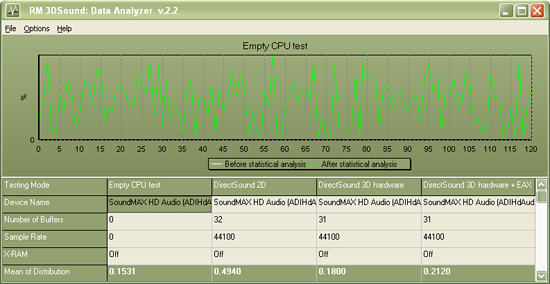
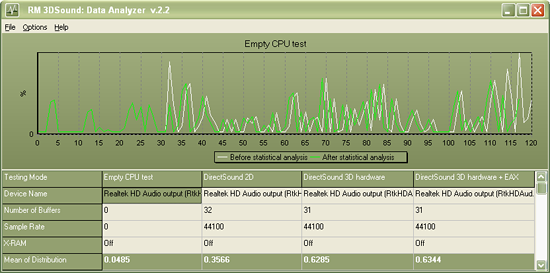
We are no longer showing the individual CPU utilization rates as the use of a dual core processor means the driver load is balanced between each processor with either audio solution. The 2.3 version of Rightmark properly supports dual core processors now but considering the results presented for review they are almost meaningless for these users at this time. We have found the CPU utilization rate improvements with the dual-core setup in this test do not have any bearing on actual game benchmarks as the reduction in frame rate percentages are the same on our single core systems.
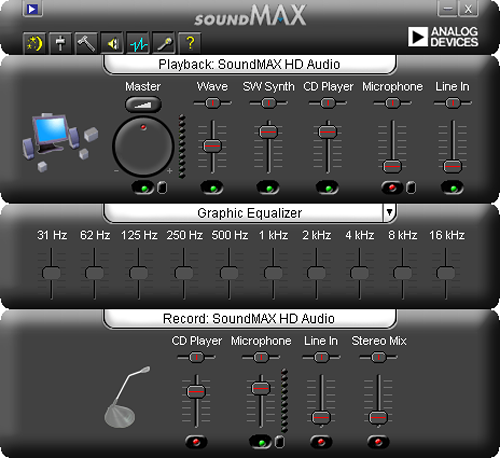
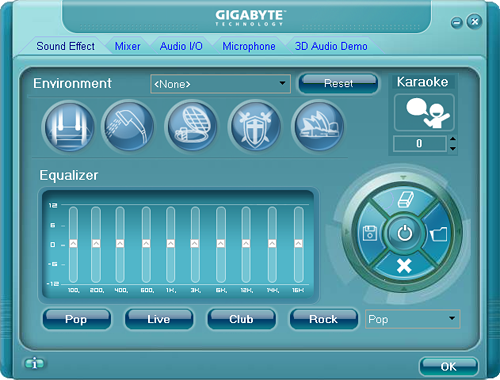
ASUS has recently switched over to the Analog Devices SoundMAX series of HD Audio Codecs with the balance of manufacturers still using the Realtek ALC-88x HD Audio Codecs. Both audio chipset manufacturers offer equal settings in their applications although we prefer the look of the ADI control panel and the fact that most of the settings are available on the front screen. We are using the 4530 driver release for the ADI codecs and the 1.47 driver release for the Realtek codecs.
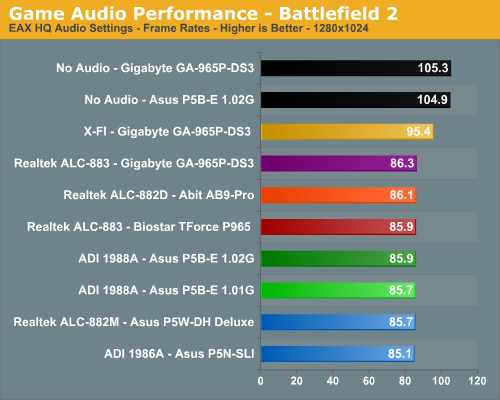

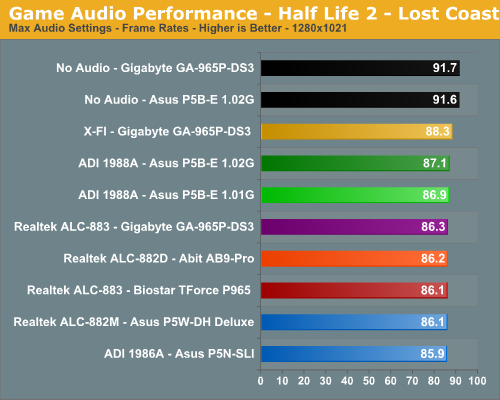
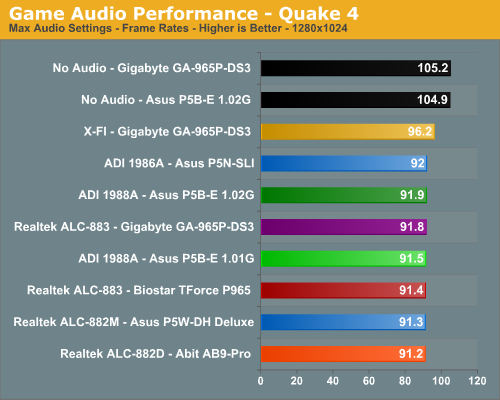

The audio performance numbers remain consistent between the Analog Devices and Realtek Codecs but both finish consistently behind the SoundBlaster X-FI in the benchmarks. This is to be expected as the ADI and Realtek Codecs are host processing units dependent upon the CPU and drivers for generating their audio streams. The SoundBlaster X-FI on the other hand has dedicated hardware that generates its audio streams and off loads this burden from the CPU. We are finding the CPU utilization to be constantly decreasing for the on-board solutions as CPU processing power increases and driver optimizations improve but they still take a toll in certain games. This is reflected in our numbers as Battlefield 2 has an average loss of 22% (was 28%), Quake 4 at 14% (was 21%), Half Life 2- Lost Coast at 5%, Company of Heroes at 5%, and Rise of Legends at 22%.
Rise of Legends is a very CPU intensive game with numerous sound effects and as such the CPU hit for generating audio is significant although we did not notice any stuttering during game play. Battlefield 2 utilizes EAX 2 for our ADI and Realtek HD Codecs which creates another significant on the CPU to process the audio streams, especially with the sound effects set to high. Quake 4 is the exception to the rule as it is generally GPU limited leaving additional CPU cycles for audio processing. In this case the ADI and Realtek solutions still create a large hit on frame rates in this game where frame rates are everything.
Analog Devices has made news lately claiming other host-based audio solutions (aimed at Realtek) do not properly generate EAX compatible audio in their drivers. During our testing we found this to be true to some degree. Since our previous Realtek testing always compared EAX 2 to the X-FI series we basically assumed some of the muddy audio (complete lack of obstructions and occlusions) we encountered in Battlefield 2 as an example were just issues with the Codec or a poor implementation of EAX 2 in the drivers. After comparing the ADI 1988A to the Realtek ALC-882D in Battlefield 2 we completely agree the issues we heard before are strictly driver related. In fact, the ADI 1988A generated EAX 2 sound effects that were very close or equal to our Audigy 2 and within hearing distance of our X-FI. The audio quality difference in EAX capable games between the ADI and Realtek HD Audio Codecs were almost startling. We firmly believe this is due to obstructions and occlusions not being implemented correctly in the Realtek drivers.
The audio differences in other games such as Company of Heroes were minimal although you could still tell the difference. This was especially true in the CoH benchmark where the two Ammerican soldiers are treading through the water to meet their group. You could hear the water gently move as they walked while with the Realtek solution the water sounded like a wet mop. This pattern held true for all of our games we tested throughout the benchmark process including twenty five games that we tested off-line. While ADI has had some driver issues in the past we found both the 4530 and 4570 drivers to be very stable and almost problem free. We have some reports of ADI driver issues from our readers that we are still investigating at this time with the ASUS P5B-Deluxe board. We believe ASUS made the right decision to switch to ADI for their more enthusiast level boards at this time.
Obviously, if you are a serious gamer, then a dedicated sound card is still useful to ensure consistent frame rate averages across a wide variety of games, and in the case of the Sound Blaster X-FI, you also get improved audio quality and EAX3/4/5 support. If you'd like more details on the Realtek or ADI solutions, you can refer to the Realtek HD Audio Codec Specifications or SoundMAX HD Audio Codec Specifications .
We limited audio testing to the Rightmark 3D Sound version 2.3 CPU utilization test and tested with sound enabled to show the performance effects on several games. The Rightmark 3D Sound benchmark measures the overhead or CPU utilization required by a codec or hardware audio chip.


We are no longer showing the individual CPU utilization rates as the use of a dual core processor means the driver load is balanced between each processor with either audio solution. The 2.3 version of Rightmark properly supports dual core processors now but considering the results presented for review they are almost meaningless for these users at this time. We have found the CPU utilization rate improvements with the dual-core setup in this test do not have any bearing on actual game benchmarks as the reduction in frame rate percentages are the same on our single core systems.


ASUS has recently switched over to the Analog Devices SoundMAX series of HD Audio Codecs with the balance of manufacturers still using the Realtek ALC-88x HD Audio Codecs. Both audio chipset manufacturers offer equal settings in their applications although we prefer the look of the ADI control panel and the fact that most of the settings are available on the front screen. We are using the 4530 driver release for the ADI codecs and the 1.47 driver release for the Realtek codecs.





The audio performance numbers remain consistent between the Analog Devices and Realtek Codecs but both finish consistently behind the SoundBlaster X-FI in the benchmarks. This is to be expected as the ADI and Realtek Codecs are host processing units dependent upon the CPU and drivers for generating their audio streams. The SoundBlaster X-FI on the other hand has dedicated hardware that generates its audio streams and off loads this burden from the CPU. We are finding the CPU utilization to be constantly decreasing for the on-board solutions as CPU processing power increases and driver optimizations improve but they still take a toll in certain games. This is reflected in our numbers as Battlefield 2 has an average loss of 22% (was 28%), Quake 4 at 14% (was 21%), Half Life 2- Lost Coast at 5%, Company of Heroes at 5%, and Rise of Legends at 22%.
Rise of Legends is a very CPU intensive game with numerous sound effects and as such the CPU hit for generating audio is significant although we did not notice any stuttering during game play. Battlefield 2 utilizes EAX 2 for our ADI and Realtek HD Codecs which creates another significant on the CPU to process the audio streams, especially with the sound effects set to high. Quake 4 is the exception to the rule as it is generally GPU limited leaving additional CPU cycles for audio processing. In this case the ADI and Realtek solutions still create a large hit on frame rates in this game where frame rates are everything.
Analog Devices has made news lately claiming other host-based audio solutions (aimed at Realtek) do not properly generate EAX compatible audio in their drivers. During our testing we found this to be true to some degree. Since our previous Realtek testing always compared EAX 2 to the X-FI series we basically assumed some of the muddy audio (complete lack of obstructions and occlusions) we encountered in Battlefield 2 as an example were just issues with the Codec or a poor implementation of EAX 2 in the drivers. After comparing the ADI 1988A to the Realtek ALC-882D in Battlefield 2 we completely agree the issues we heard before are strictly driver related. In fact, the ADI 1988A generated EAX 2 sound effects that were very close or equal to our Audigy 2 and within hearing distance of our X-FI. The audio quality difference in EAX capable games between the ADI and Realtek HD Audio Codecs were almost startling. We firmly believe this is due to obstructions and occlusions not being implemented correctly in the Realtek drivers.
The audio differences in other games such as Company of Heroes were minimal although you could still tell the difference. This was especially true in the CoH benchmark where the two Ammerican soldiers are treading through the water to meet their group. You could hear the water gently move as they walked while with the Realtek solution the water sounded like a wet mop. This pattern held true for all of our games we tested throughout the benchmark process including twenty five games that we tested off-line. While ADI has had some driver issues in the past we found both the 4530 and 4570 drivers to be very stable and almost problem free. We have some reports of ADI driver issues from our readers that we are still investigating at this time with the ASUS P5B-Deluxe board. We believe ASUS made the right decision to switch to ADI for their more enthusiast level boards at this time.
Obviously, if you are a serious gamer, then a dedicated sound card is still useful to ensure consistent frame rate averages across a wide variety of games, and in the case of the Sound Blaster X-FI, you also get improved audio quality and EAX3/4/5 support. If you'd like more details on the Realtek or ADI solutions, you can refer to the Realtek HD Audio Codec Specifications or SoundMAX HD Audio Codec Specifications .










62 Comments
View All Comments
vailr - Saturday, October 21, 2006 - link
Re:So, how about the (yet unreleased) ATI and NVidia Conroe chipset boards?
Does either chipset include PATA support?
Thanks.
Gary Key - Saturday, October 21, 2006 - link
They both have native support for two drives.
n7 - Saturday, October 21, 2006 - link
Gary, always love your reviews!I read thru the whole thing, & it was a good read :)
Meticulous detail, as well great sarcastic humor as well.
I look forward to the following parts.
Sho - Friday, October 20, 2006 - link
In an earlier AnandTech article, the one about Kentsfield support, it was written that Gigabyte would bring a revision 2.0 of all of their P965 boards to the market in mid-October, including the DS3. The article does not mention whether the board tested was this new rev 2,9 or any other. Could that be clarified?And does anybody know what was changed/fixed in 2.0?
Gary Key - Friday, October 20, 2006 - link
Gigabyte has not released any further details on the revision 2 boards except for the fact they were addressing some layout issues and possible BIOS improvements. The only major change we could see them making would be going from a three phase power design on the DS3 to a five phase system as an example. The board we tested is still revision 1.Sho - Saturday, October 21, 2006 - link
Thanks!dreddly - Friday, October 20, 2006 - link
'caliper' should be caliber on AB9Pro pageGreat work on this roundup though, impressive job.
Puddyglum1 - Friday, October 20, 2006 - link
Which board? The topic of the previous page was about sound cards vs. onboard audio. Is there a missing page? Why is there a picture of the Asus heatsink and no mention of which board is the preferred of the bunch?Just some questions =)
Great article for Cost/Performance comparison.
Puddyglum1 - Friday, October 20, 2006 - link
Woah, there's a lot more there now. Thanks for the explanation.I just built a workstation for a client using the 965P-DS3, but the board was DOA. I went to a local shop and picked up a 965P-S3 instead (seeing as how the only main feature missing was the solid capacitors of the -DS3), and it performed just as well as the DS3. For $110, a GA-965P-S3 would be the best Cost/Performance of the 965P bunch, in my unresearched opinion.
JarredWalton - Friday, October 20, 2006 - link
Now you're skipping ahead to part 2! :p